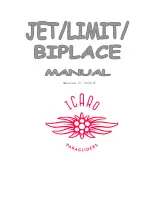
11
capacity to resist the G forces increases and you will learn to fully appreciate
and understand the manoeuvre. always practice this manoeuvre when flying
at high altitude.
To start the manoeuvre, first lean your bodyweight and pull the brake line to
the side to which you are leaning. You can regulate the intensity of the turn
by applying a little outside brake. a paraglider flying at its maximum turn
speed can reach –20 m/s, equivalent 70 km/h vertical speed and stabilize in
a spiral dive from 15 m/s onwards.
These are the reasons why you should be familiar with the manoeuvre and
know how to carry out the exit methods. To exit this manoeuvre you must
progressively release the inside brake and also momentarily apply outside
brake. Whilst doing this you must also lean your bodyweight towards the
outside. This exit manoeuvre must to be carried out gradually and with
smooth movements so you can feel the pressure and speed changes at the
same time. on exiting this manoeuvre the glider will rock briefly with a lateral
surge, the intensity will depend on how the manoeuvre has been carried out.
Practice these movements at sufficient altitude and in moderation
We recommend not using this technique often because this will age your
glider and lines prematurely.
5.4 THe WeATHer TeCHNIQUe
This technique is the most simple descent technique, allowing your glider to
remain in normal flight without forcing the structure. Locate the metrological
descend zone (sinking air) and turn in it as you would do for ascending.
6. SPECIAL METHODS
6.1 TOWING
The iCePeaK 3 does not experience any problem whilst being towed. only
qualified personnel should handle the qualified equipment to carry out this
operation. The wing has to be inflated in the same way as in normal flight.
6.2 ACrOBATIC FlIGHT
although the iCePeaK 3 has been tested by expert acrobatic pilots in extreme
situations, it Has noT been designed for acrobatic flight and we Do noT
reCoMMenD THe Use oF THis GLiDer for that use. We consider acrobatic
flight to be a form of piloting that is different to normal flight. To learn safely how
to master acrobatic manoeuvres you should attend lessons, which are carried
out and supervised by a qualified instructor over water. extreme manoeuvres
take you and your wing to centrifugal forces that can reach 4 to 5g. Materials
will wear more quickly than in normal flight. if you do a lot of extreme
manoeuvres we recommend a line check at least every 6 months.
7. FOLDING INSTRUCTIONS
The iCePeaK 3 has a very complex leading edge, manufactured using a
variety of different materials. For that reason and to extend the useful life
of your paraglider, the use of a correct folding method is very important
The iCePeaK 3 has been designed using Flexirods not only on the leading
edge but also with Flexirods on the profile, inside the glider. because of this
care must be taken when packing and folding the glider. The most efficient
way to ensure the Flexirods remain damage free is to carefully “concertina”
the Flexirods together and fold in no more than 3 sections, taking care not
to bend or twist the leading edge Flexirods. Then loosely secure with the
compression strap and place everything within glider bag supplied.
if you do not intend to fly for more than a week we would advise you to unfold
your glider and store it straight, to keep the Flexirods in shape.
8. CARE AND MAINTENANCE
8.1 MAINTeNANCe
Careful maintenance of your equipment will ensure continued performance.
The fabric and the lines do not need to be washed, if they become dirty,
clean them gently with a soft damp cloth. if your wing becomes wet with salty
Содержание ICEPEAK 3 22
Страница 1: ...ICEPEAK 3 USER S MANUAL The result of perfection...
Страница 13: ...13...
Страница 16: ...16 11 3 RISER ARRANGEMENT...
Страница 17: ...17 11 4 LINE PLAN...
Страница 22: ...niviuk com The importance of small details Bisgr fic...

































